User:Cease/Moria: Difference between revisions
No edit summary |
|||
| Line 43: | Line 43: | ||
''See also: [[Balrog]]'' | ''See also: [[Balrog]]'' | ||
The [[Balrog]] stands more or less on his own, but can't sustain a deck on its own. Think of it more as something you [[splash]] into a deck to supplement its main strategy, even if you're splashing it into a {{C|Moria}} deck. It's most popular in [[Fellowship Block]], where it can be [[download]]ed at [[site]] 5, {{Card|The Bridge of Khazad-dum}}, but can't be played at any other site except some versions of site 4. If you do use it, use {{ | The [[Balrog]] stands more or less on his own, but can't sustain a deck on its own. Think of it more as something you [[splash]] into a deck to supplement its main strategy, even if you're splashing it into a {{C|Moria}} deck. It's most popular in [[Fellowship Block]], where it can be [[download]]ed at [[site]] 5, {{Card|The Bridge of Khazad-dum}}, but can't be played at any other site except some versions of site 4. If you do use it, use {{Card|The Balrog, Flame of Udun}} for {{C|Moria}} goblin swarm, and {{Card|The Balrog, Durin's Bane}} for any other deck. The main reason not to is because the counters to the Balrog are powerful and versatile cards in their own right: {{Card|Hobbit Stealth}}, {{Card|Boromir, Lord of Gondor}}, {{Card|Armor}}, {{Card|Gimli's Helm}}, and {{Card|Filibert Bolger, Wily Rascal}}. Even if your opponent doesn't have a counter, they may just be able to sacrifice a used-up support character like {{Card|Sam, Son of Hamfast}} or {{Card|Merry, Friend to Sam}}. {{Card|Whip of Many Thongs}} counters some of these cards, but not all of them, and it's useless unless you already have it in your hand when your opponent gets to site 5. | ||
In later blocks, the Balrog just isn't very useful. [[Decipher]] tried to address its weaknesses, but there are too few [[Underground]] sites and its Twilight cost stayed far too high for too long, scuttling those attempts. (Compare {{Card|Troll of Cirith Gorgor}} to {{Card|The Balrog, Terror of Flame and Shadow}} and {{Card|The Balrog, The Terror of Khazad-dum}}.) {{Card|The Balrog, Demon of Might}} is probably the only one worth seriously considering, as a [[splash]] into Underground {{C|Orc}} [[Lurker]]s, but even then you'll want to make sure it doesn't interfere with any [[Maneuver Phase]] abilities you might want to use. | In later blocks, the Balrog just isn't very useful. [[Decipher]] tried to address its weaknesses, but there are too few [[Underground]] sites and its Twilight cost stayed far too high for too long, scuttling those attempts. (Compare {{Card|Troll of Cirith Gorgor}} to {{Card|The Balrog, Terror of Flame and Shadow}} and {{Card|The Balrog, The Terror of Khazad-dum}}.) {{Card|The Balrog, Demon of Might}} is probably the only one worth seriously considering, as a [[splash]] into Underground {{C|Orc}} [[Lurker]]s, but even then you'll want to make sure it doesn't interfere with any [[Maneuver Phase]] abilities you might want to use. | ||
Revision as of 23:52, 2 January 2022
Moria is the abandoned dwarven underground city of Khazad-dûm, now dominated by stunted goblins and a nameless fear. In this game, it is a Shadow culture that focuses on swarming the opponent with many small orc minions, plus the occasional larger minion that dwells in Moria, such as the Cave Troll of Moria, Scourge of the Black Pit (1R165)
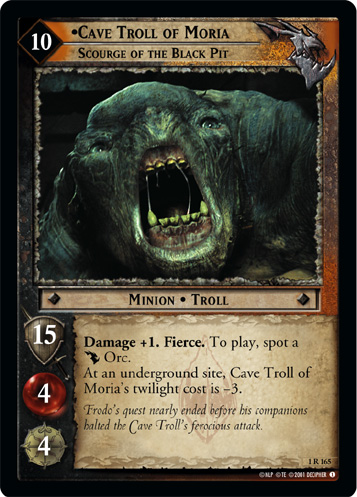 , Watcher in the Water, Keeper of Westgate (2R73)
, Watcher in the Water, Keeper of Westgate (2R73)
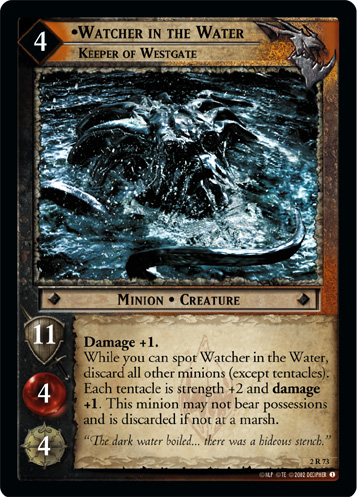 and its tentacles, and the Balrog.
and its tentacles, and the Balrog. Moria was one of the first cultures introduced to this game, and unlike most of the original cultures, it's always been focused tightly on one strategy: using the faction's hand extension and recursion tools to set up an engine to play many more minions than you'd otherwise be able to play at once.
Part of why Moria is so tightly focused is because the bulk of the culture's cards came out in Fellowship Block. Only a handful of new cards came out for the culture after that, most of them focused on the Balrog. The Shadows set basically retired
Moria as part of its culture reorganization, merging most of it into
Orc culture. The only
Moria cards in the post-Shadows sets are the Balrog and cards to support the Balrog, as well as the Watcher in the Water, Many-tentacled Creature (19P21)
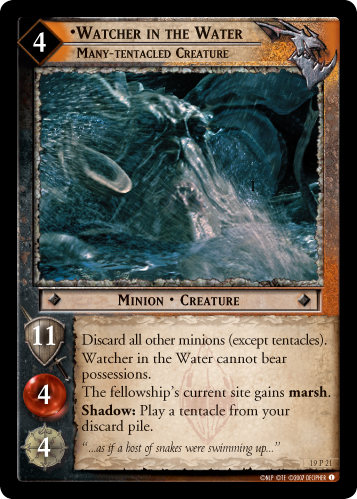 and its various tentacles. In those sets, the teeming goblins of Moria are Lurkers, and they and the Cave Troll of Moria, Savage Menace (12R85)
and its various tentacles. In those sets, the teeming goblins of Moria are Lurkers, and they and the Cave Troll of Moria, Savage Menace (12R85)
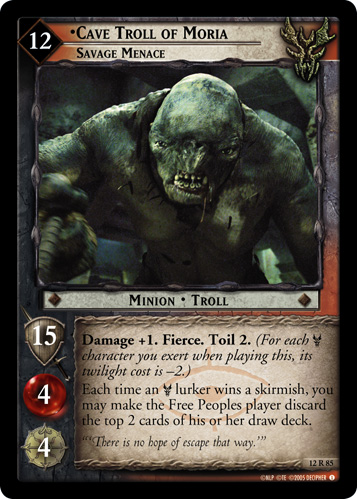 are part of the
are part of the Orc culture.
Moria is one of the premiere Shadow sides of Fellowship Block, particularly because its strong matchup against choke. After that, historically it fell off. Few cards were added to the culture in later sets, limiting its versatility and leaving it vulnerable to power creep. The site path in later formats generates more Twilight, weakening the choke decks it preyed upon. A key card, Relics of Moria (1R195)
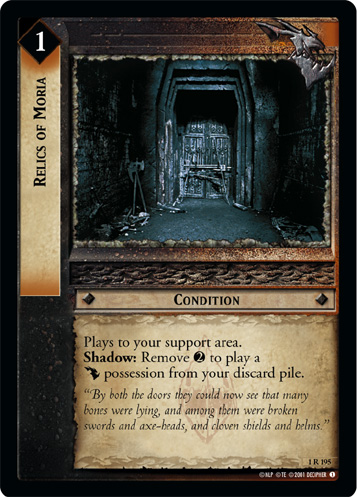 , was restricted or banned in some formats. Despite all this, on GEMP in 2021, it remains reasonably popular in later formats where Fellowship Block cards are allowed (save possibly Expanded), because of familiarity and strong cycling.
, was restricted or banned in some formats. Despite all this, on GEMP in 2021, it remains reasonably popular in later formats where Fellowship Block cards are allowed (save possibly Expanded), because of familiarity and strong cycling.
The Moria Engine
Every deck focused on chiefly Moria culture uses a variation of this engine. It even appears in most hybrid decks, like Moria Navy. (The main exception is Stupid Swarm, which is a rainbow strategy with too few
Moria minions to make this work.)
The core cards of the Moria engine are multiple copies of both Goblin Scimitar (1C180)
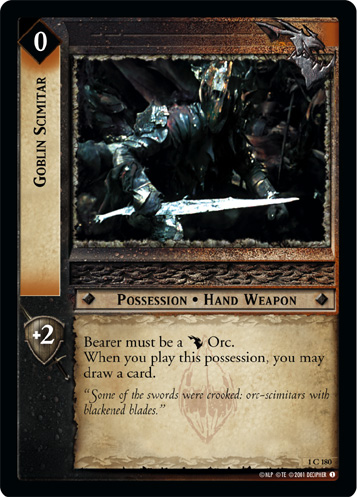 and Goblin Armory (1R173)
and Goblin Armory (1R173)
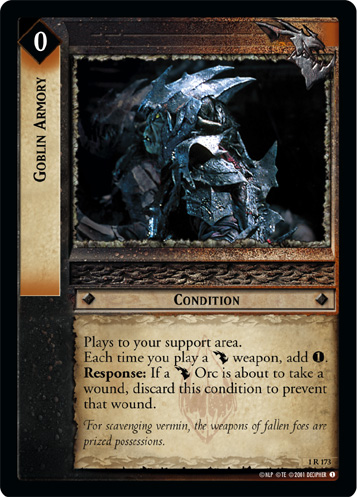 . Each scimitar replaces itself in your hand by drawing an additional card, and generates up to four additional Twilight, allowing you to pay for more minions even against choke decks. Every other key card plugs into this engine.
. Each scimitar replaces itself in your hand by drawing an additional card, and generates up to four additional Twilight, allowing you to pay for more minions even against choke decks. Every other key card plugs into this engine.
Goblin Runner (1U178)
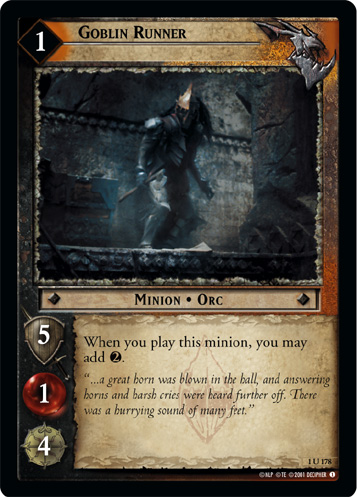 and Moria Scout (1C191)
and Moria Scout (1C191)
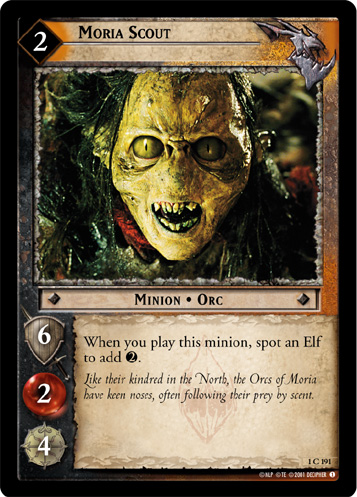 generate as much or more Twilight than they cost, helping you play every single minion in your hand. Goblin Scavengers (1C179)
generate as much or more Twilight than they cost, helping you play every single minion in your hand. Goblin Scavengers (1C179)
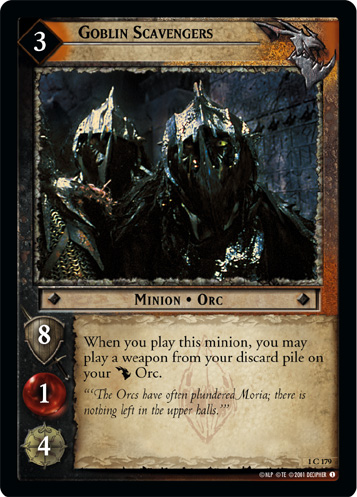 and Relics of Moria (1R195)
and Relics of Moria (1R195)
 allow you to replay your scimitars from the discard pile, drawing even more cards. With enough copies of Goblin Armory out, they even generate more Twilight than they cost. Then, to replay your various goblins, you have Host of Thousands (1C187)
allow you to replay your scimitars from the discard pile, drawing even more cards. With enough copies of Goblin Armory out, they even generate more Twilight than they cost. Then, to replay your various goblins, you have Host of Thousands (1C187)
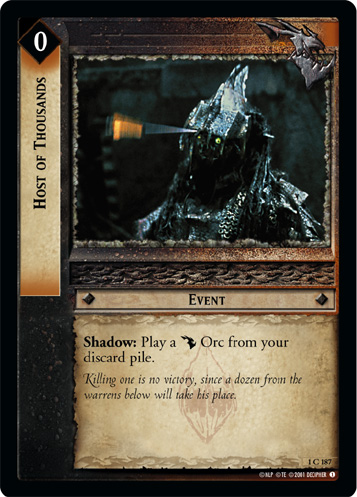 and Goblin Swarms (1R183)
and Goblin Swarms (1R183)
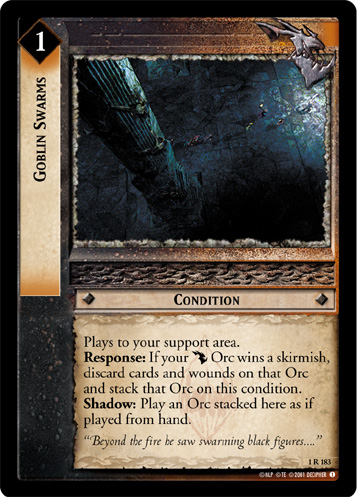 . If any useless cards are clogging up your hand, they can be turned into useful goblins with They Are Coming (1C196)
. If any useless cards are clogging up your hand, they can be turned into useful goblins with They Are Coming (1C196)
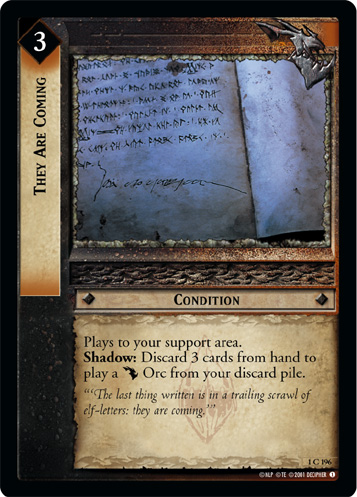 .
.
There are a few weaker, less-popular additions to the engine. Threat of the Unknown (1C197)
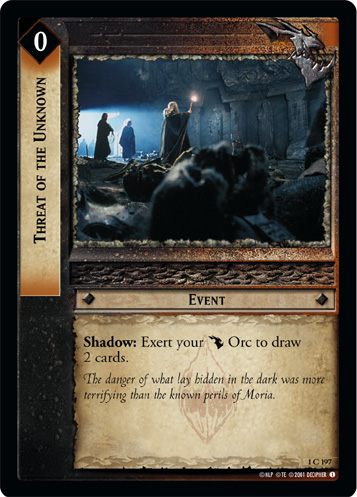 and The Underdeeps of Moria (1R200)
and The Underdeeps of Moria (1R200)
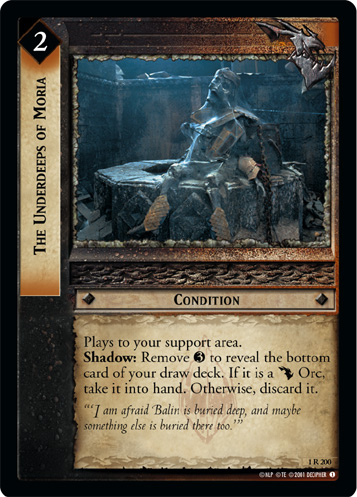 can draw more cards. Plundered Armories (1C193)
can draw more cards. Plundered Armories (1C193)
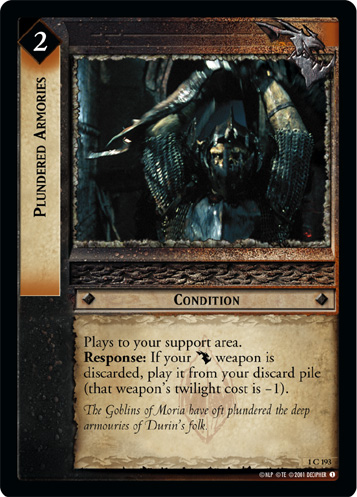 can prevent your weapons from going to waste, as well as draw some extra cards for your next turn. Foul Things (2U59)
can prevent your weapons from going to waste, as well as draw some extra cards for your next turn. Foul Things (2U59)
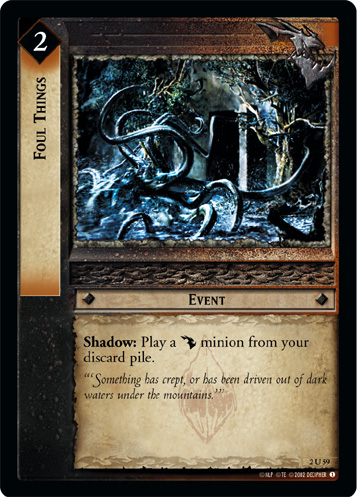 can be played as a fifth or sixth copy of Host of Thousands, but it is expensive.
can be played as a fifth or sixth copy of Host of Thousands, but it is expensive.
The rest of the deck consists of the rest of your minions, as well as occasional utility cards. Besides the minions above, popular minions in the traditional Moria swarm deck include Goblin Backstabber (1C174)
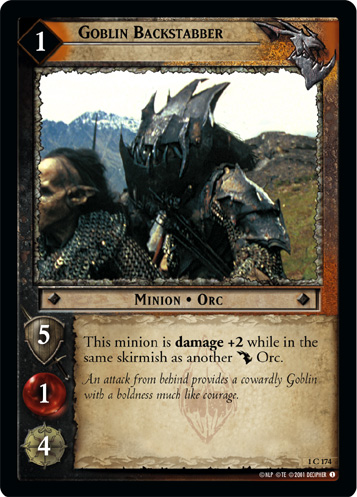 , Goblin Sneak (1U181)
, Goblin Sneak (1U181)
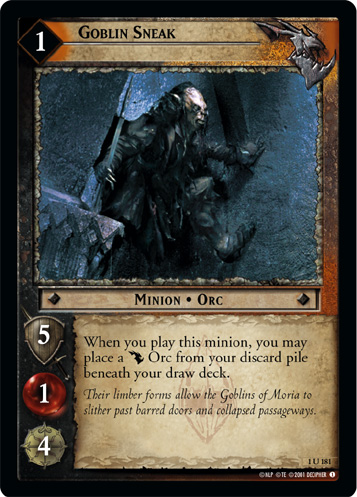 , Goblin Wallcrawler (1C184)
, Goblin Wallcrawler (1C184)
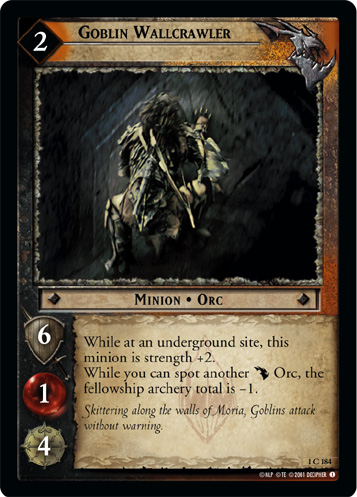 , Goblin Pursuer (2C62)
, Goblin Pursuer (2C62)
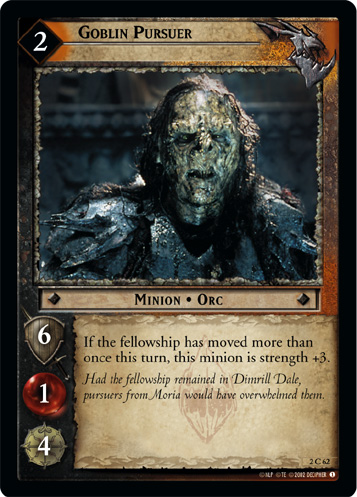 , and Troll’s Keyward (1R199)
, and Troll’s Keyward (1R199)
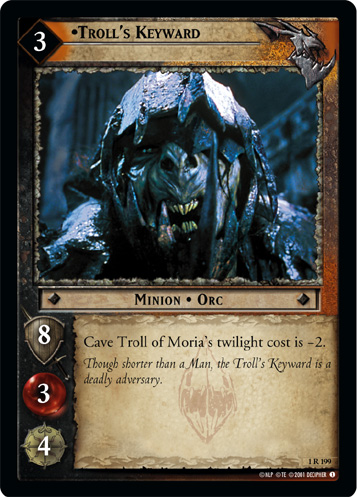 (even if you aren't playing the Cave Troll). Also fairly common as one- or two-ofs are Ancient Chieftain (1R163)
(even if you aren't playing the Cave Troll). Also fairly common as one- or two-ofs are Ancient Chieftain (1R163)
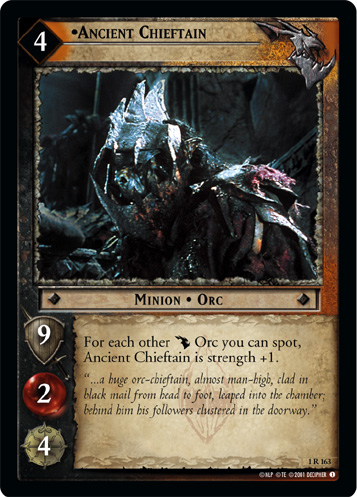 , Goblin Scrabbler (2C64)
, Goblin Scrabbler (2C64)
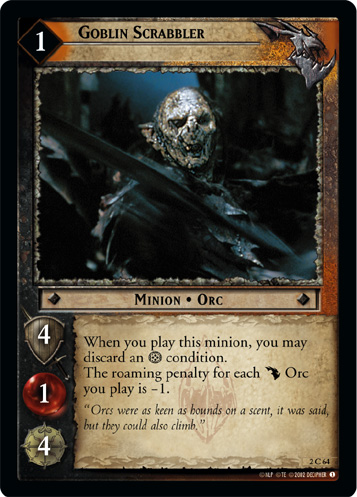 , Goblin Warrior (1C185)
, Goblin Warrior (1C185)
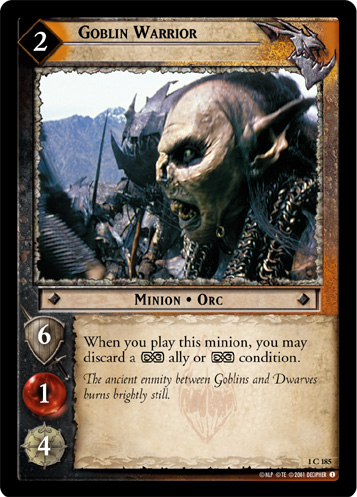 , Guard Commander (1R186)
, Guard Commander (1R186)
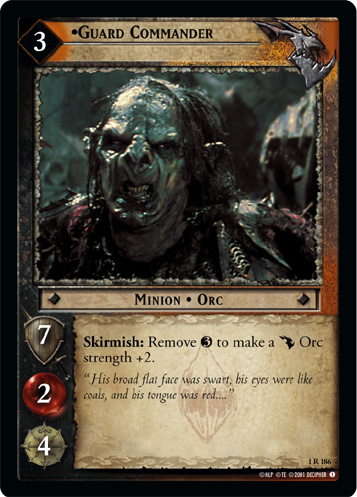 , Goblin Flankers (2C61)
, Goblin Flankers (2C61)
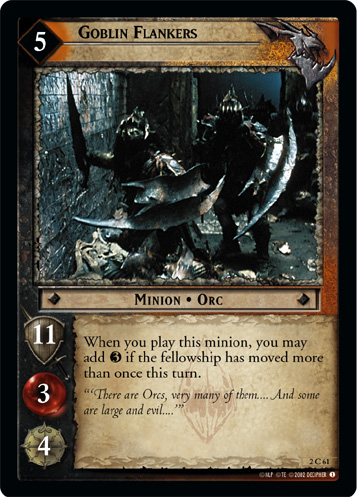 , Úlairë Enquëa, Lieutenant of Morgul (1U231)
, Úlairë Enquëa, Lieutenant of Morgul (1U231)
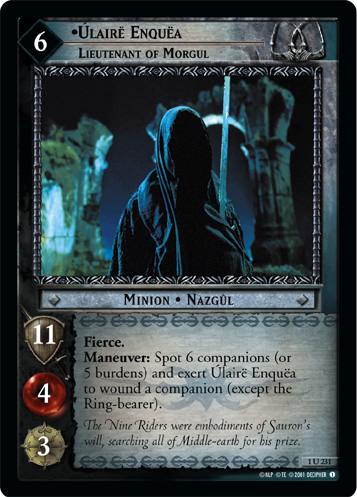 , and Úlairë Nertëa, Messenger of Dol Guldur (1U234)
, and Úlairë Nertëa, Messenger of Dol Guldur (1U234)
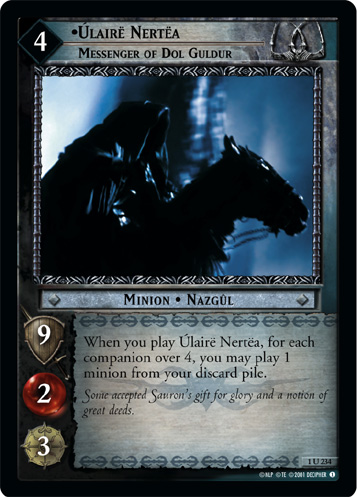 . Somewhat popular utility cards include Such a Little Thing (3R80)
. Somewhat popular utility cards include Such a Little Thing (3R80)
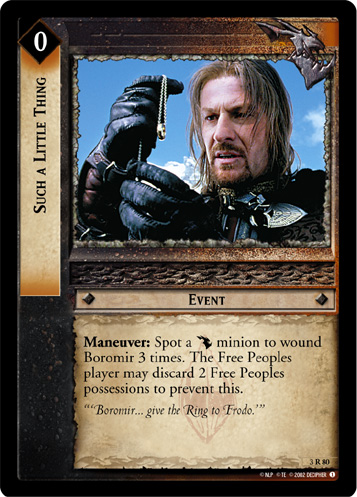 , Goblin Domain (1R175)
, Goblin Domain (1R175)
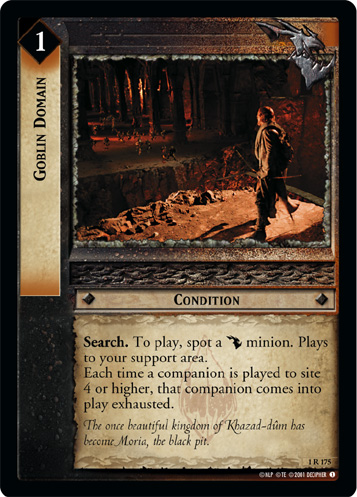 , and Relentless (1U194)
, and Relentless (1U194)
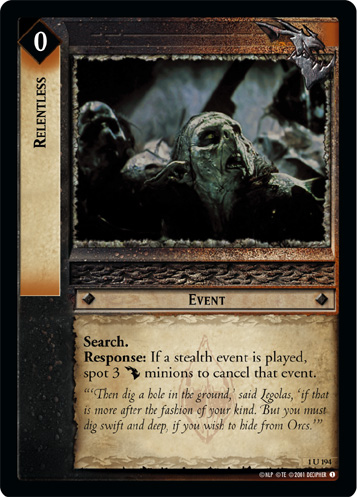 , all three of which are chiefly useful exclusively in Fellowship Block.
, all three of which are chiefly useful exclusively in Fellowship Block.
Some decks also include a few larger minions, to use up any remaining Twilight and put some pressure on higher-strength skirmishers. Be careful about running too many of these, because they can clog up your hand if you can't afford them. The most popular big breakers are the two Moria monsters, The Balrog, Flame of Udun (2R52)
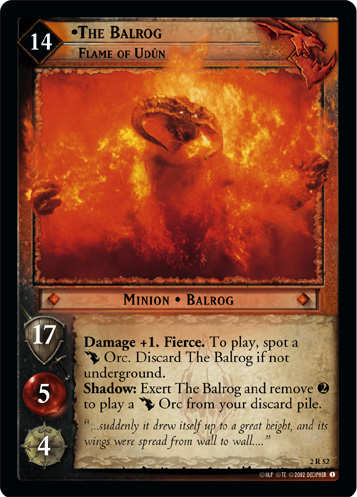 (always a one-of, and almost exclusively in Fellowship Block, and occasionally in conjunction with Goblin Spear (1C182)
(always a one-of, and almost exclusively in Fellowship Block, and occasionally in conjunction with Goblin Spear (1C182)
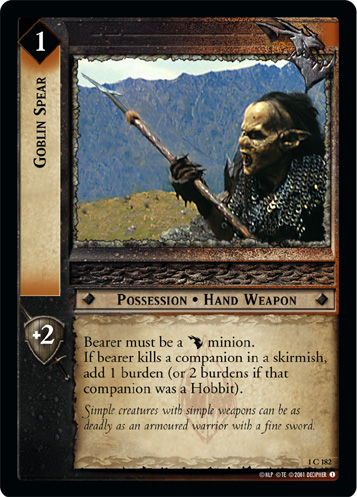 ), Cave Troll of Moria, Scourge of the Black Pit (1R165)
), Cave Troll of Moria, Scourge of the Black Pit (1R165)
 (generally in conjunction with Troll’s Keyward (1R199)
(generally in conjunction with Troll’s Keyward (1R199)
 ), although any of the Moria Beatdown minions can also serve this role.
), although any of the Moria Beatdown minions can also serve this role.
Some important sites in Fellowship Block for Moria swarm:
- Site 4 - Mithril Mine (1U345)
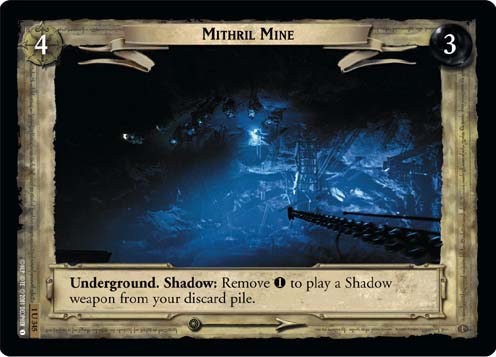 is very strong, feeding the main engine. Moria Stairway (1U347)
is very strong, feeding the main engine. Moria Stairway (1U347)
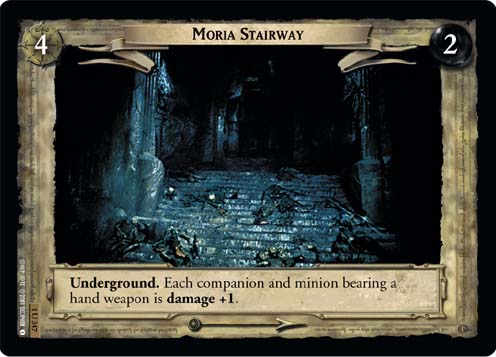 is a significantly weaker alternative.
is a significantly weaker alternative. - Site 5 - It's not like you can choose anything but The Bridge of Khazad-dûm (1C349)
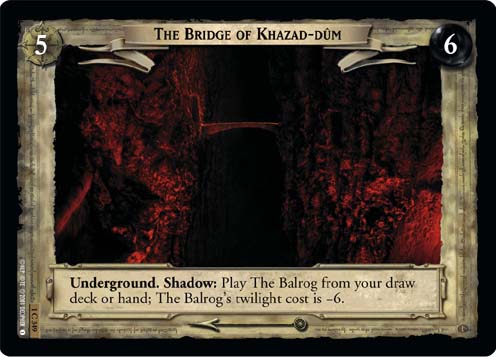 , but the Bridge can be a good reason to include one copy of The Balrog, Flame of Udun (2R52)
, but the Bridge can be a good reason to include one copy of The Balrog, Flame of Udun (2R52)
 .
. - Site 6 - Dimrill Dale (1U350)
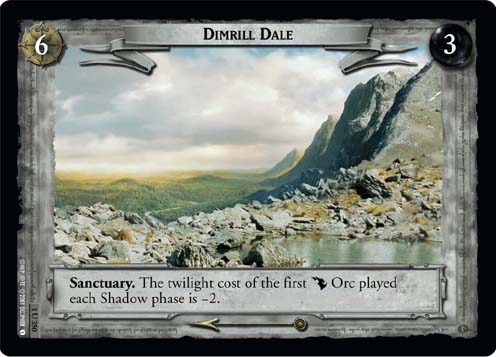 is a reasonably strong effect at a relatively weak site. Try to avoid getting stuck at Caras Galadhon (3U115)
is a reasonably strong effect at a relatively weak site. Try to avoid getting stuck at Caras Galadhon (3U115)
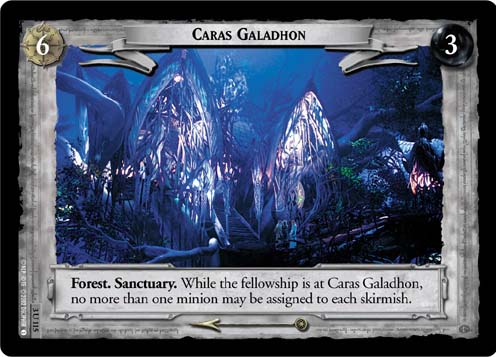 .
. - Site 7 - This deck has trouble with allies and archery, so pick your favorite of Anduin Confluence (1U353)
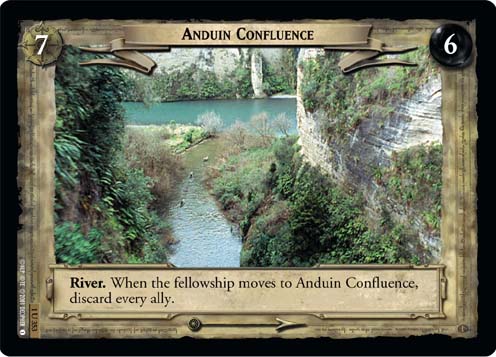 and Anduin Wilderland (1C354)
and Anduin Wilderland (1C354)
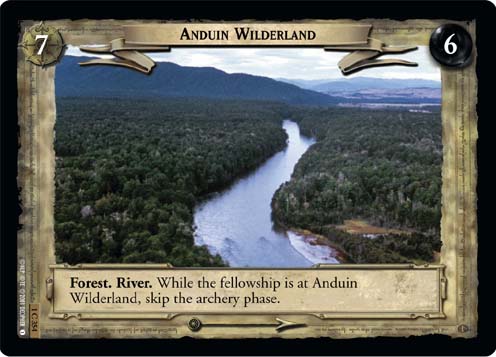 . Try to avoid The Great River (3C118)
. Try to avoid The Great River (3C118)
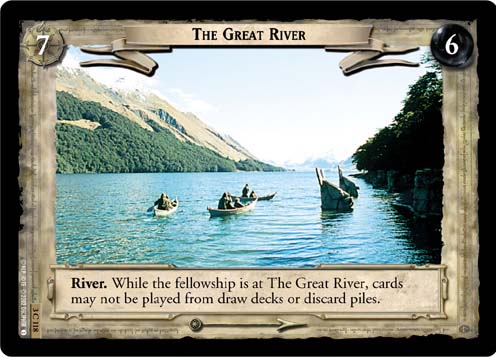 .
. - Site 8 - Shores of Nen Hithoel (1U359)
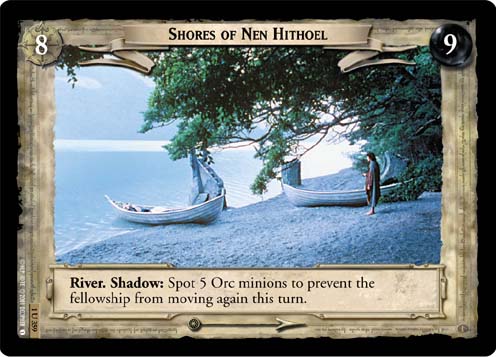 can stop a double move, while Anduin Banks (1C356)
can stop a double move, while Anduin Banks (1C356)
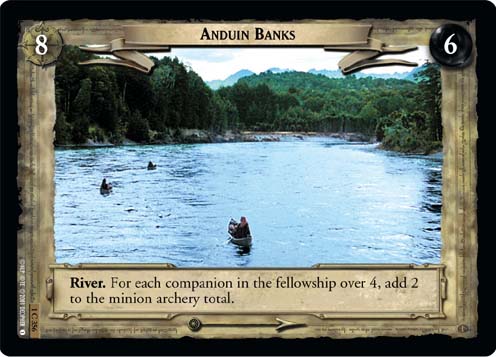 helps whittle down overly large Fellowships.
helps whittle down overly large Fellowships.
This deck was more or less unchanged after Fellowship Block, due to a lack of new cards. The only relevant Moria orc-focused cards introduced after that block are Host of Moria, Legion of the Underdeeps (9R+41)
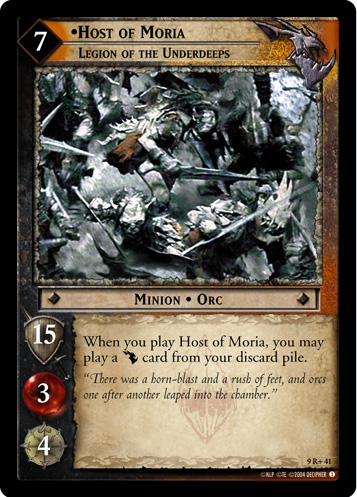 , a reasonably-efficient minion that sees some play in Moria Beatdown variants, and Durin’s Tower (6R77)
, a reasonably-efficient minion that sees some play in Moria Beatdown variants, and Durin’s Tower (6R77)
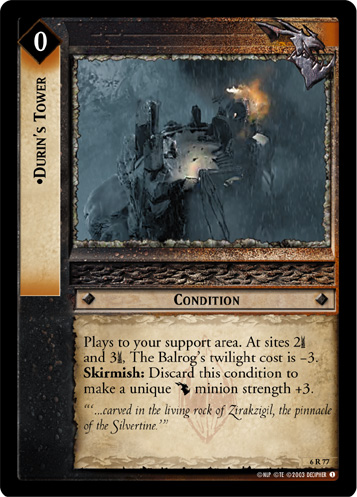 , a pump that applies to so few minions that it's rarely played, and even then never more than one or two copies. The main new additions after that block involve incorporating new cultures.
, a pump that applies to so few minions that it's rarely played, and even then never more than one or two copies. The main new additions after that block involve incorporating new cultures.
Moria swarm is a traditional swarm deck, so it has the traditional swarm weaknesses. Depending on the format, these can include Defender +1 abilities, versions of The One Ring that give the Ring-bearer strength or Hunter bonuses like The One Ring, Such a Weight to Carry (7R2)
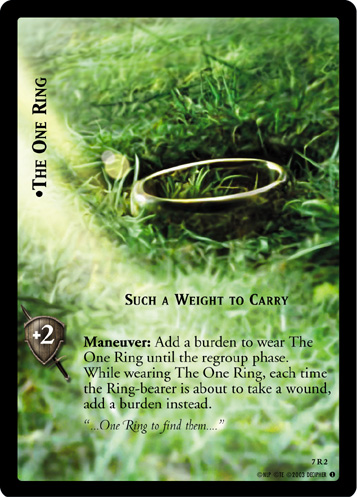 , cards that protect characters from being overwhelmed like The Tale of the Great Ring (10U116)
, cards that protect characters from being overwhelmed like The Tale of the Great Ring (10U116)
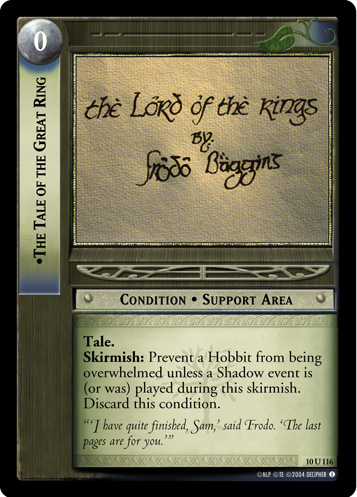 , alternate Ring-bearers with higher strength scores like Isildur, Bearer of Heirlooms (9R+33)
, alternate Ring-bearers with higher strength scores like Isildur, Bearer of Heirlooms (9R+33)
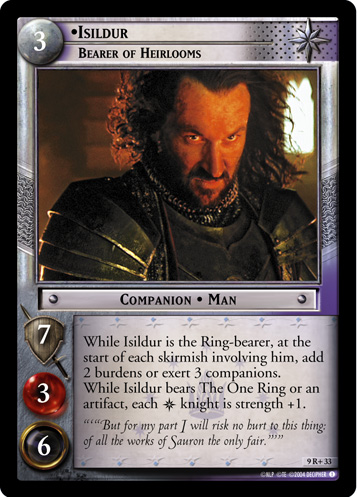 , and enough direct wounding or archery to thin out the swarm. There are also specific anti-swarm cards like Caras Galadhon (3U115)
, and enough direct wounding or archery to thin out the swarm. There are also specific anti-swarm cards like Caras Galadhon (3U115)
 and Power According to His Stature (1R308)
and Power According to His Stature (1R308)
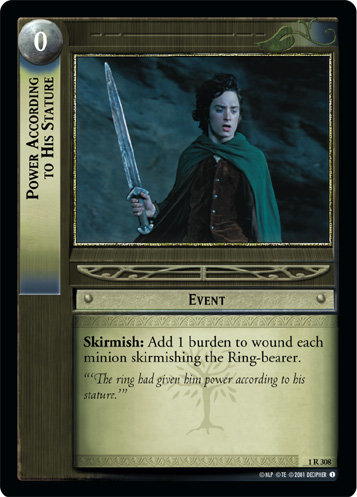 .
. Moria swarm is also reliant on its conditions, so condition removal from cards like Secret Sentinels (2R20)
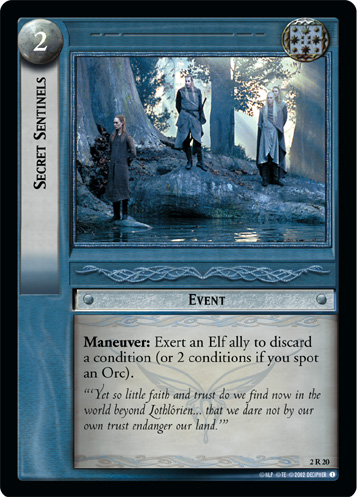 , Bilbo, Well-spoken Gentlehobbit (2U96)
, Bilbo, Well-spoken Gentlehobbit (2U96)
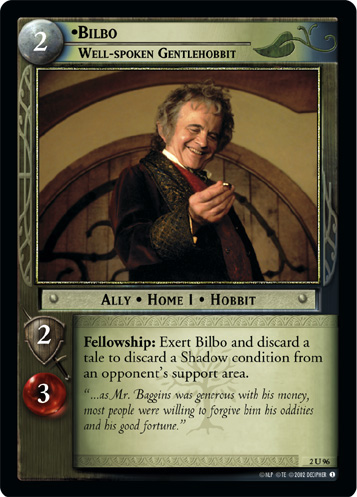 , and Sleep, Caradhras (1C84)
, and Sleep, Caradhras (1C84)
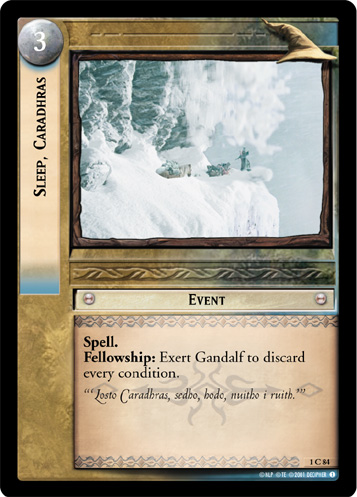 can wipe out your support area and limit the power of the engine.
can wipe out your support area and limit the power of the engine.
Variants
Moria Beatdown uses the core engine but marries it to larger minions, often equipped with a copy or two of Moria Axe (1R190)
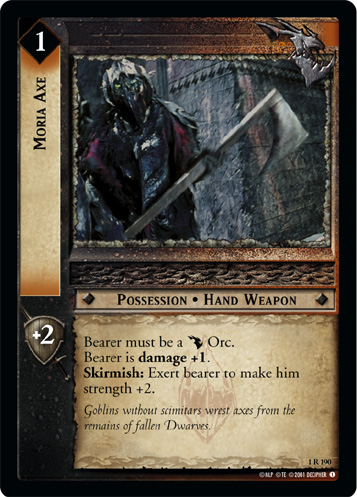 and/or Goblin Spear (1C182)
and/or Goblin Spear (1C182)
 . This deck is less concerned with swarming and overwhelming the Ring-bearer, and just wants to win skirmishes, although it's generally not going to be as good at that as a pure beatdown deck like
. This deck is less concerned with swarming and overwhelming the Ring-bearer, and just wants to win skirmishes, although it's generally not going to be as good at that as a pure beatdown deck like Isengard Uruk-hai. A beatdown deck is, of course, going to run the Cave Troll and Balrog, and is more likely to run their weapons, like Cave Troll's Hammer (1R166)
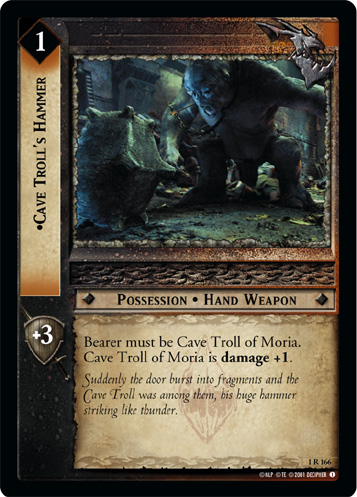 and Whip of Many Thongs (2R74)
and Whip of Many Thongs (2R74)
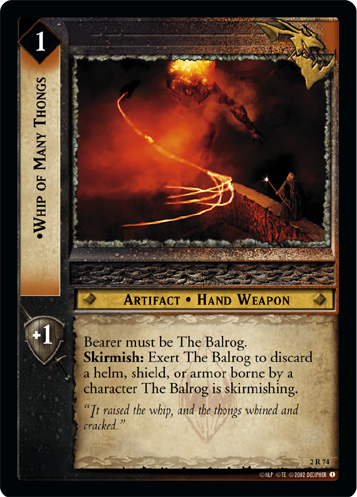 . It's more prone to run Guard Commander (1R186)
. It's more prone to run Guard Commander (1R186)
 , Goblin Flankers (2C61)
, Goblin Flankers (2C61)
 , Troll’s Keyward (1R199)
, Troll’s Keyward (1R199)
 , Host of Moria, Legion of the Underdeeps (9R+41)
, Host of Moria, Legion of the Underdeeps (9R+41)
 , and the utility Nazgul Úlairë Enquëa, Lieutenant of Morgul (1U231)
, and the utility Nazgul Úlairë Enquëa, Lieutenant of Morgul (1U231)
 and Úlairë Nertëa, Messenger of Dol Guldur (1U234)
and Úlairë Nertëa, Messenger of Dol Guldur (1U234)
 , and about the only deck that would ever run Goblin Patrol Troop (1C177)
, and about the only deck that would ever run Goblin Patrol Troop (1C177)
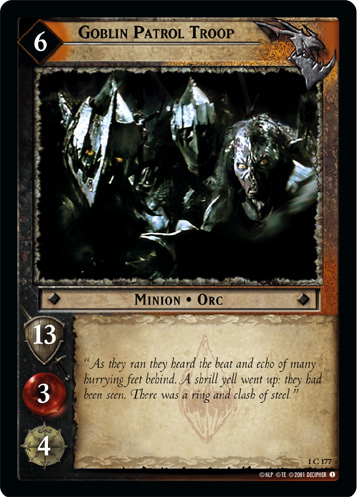 . It benefits more than most
. It benefits more than most Moria decks from Dark Places (2C55)
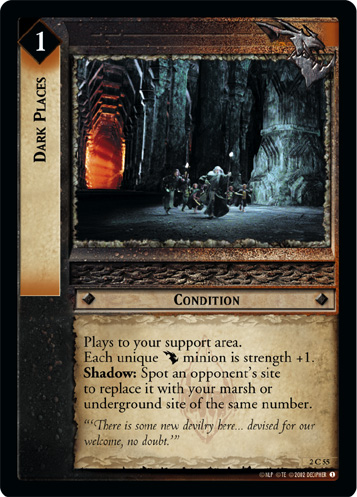 , Plundered Armories (1C193)
, Plundered Armories (1C193)
 , and Durin’s Tower (6R77)
, and Durin’s Tower (6R77)
 . It's hard to say whether Moria Beatdown is a separate deck per se: there's nothing stopping you from running a few of these cards in a regular swarm deck to give it a little extra muscle.
. It's hard to say whether Moria Beatdown is a separate deck per se: there's nothing stopping you from running a few of these cards in a regular swarm deck to give it a little extra muscle.
Moria Archery is another pure Moria variant. This deck still uses the scimitar/armories engine, but supplements the swarm with Archer minions. This bypasses some of the swarm weaknesses, but gives you worse cycling, a slightly worse matchup against choke, and leaves you vulnerable to strong archery hate cards like Hosts of the Last Alliance (2U18)
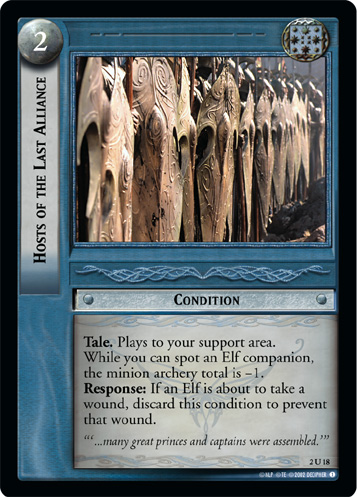 or Mithril-coat (2R105)
or Mithril-coat (2R105)
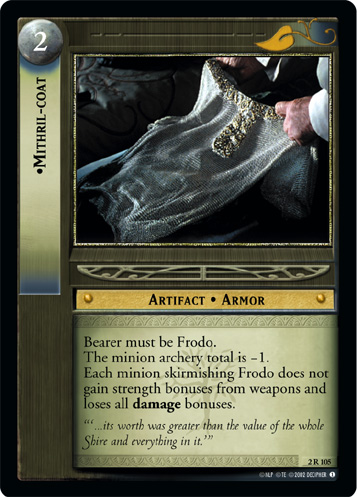 . The end result is a slightly weaker deck overall, but with different matchups. Instead of the usual cheap efficient skirmishers, it uses cheap efficient archer minions, like Goblin Bowman (2C60)
. The end result is a slightly weaker deck overall, but with different matchups. Instead of the usual cheap efficient skirmishers, it uses cheap efficient archer minions, like Goblin Bowman (2C60)
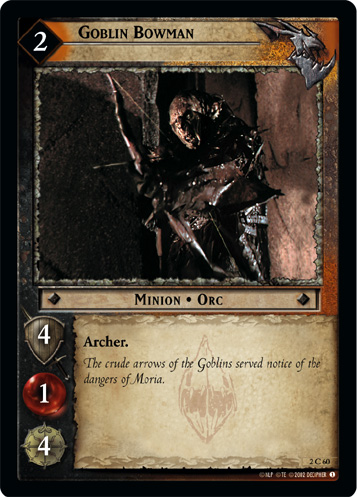 , Goblin Marksman (1C176)
, Goblin Marksman (1C176)
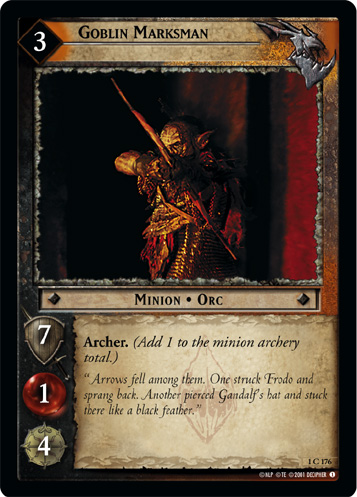 , Archer Commander (2R49)
, Archer Commander (2R49)
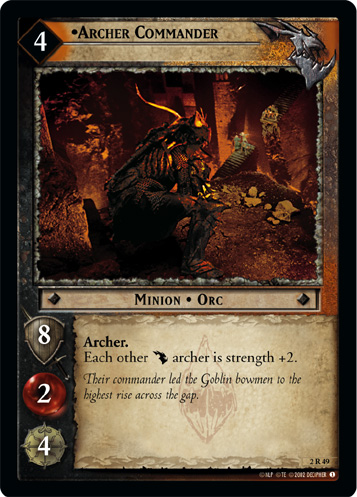 , and Moria Archer Troop (2U67)
, and Moria Archer Troop (2U67)
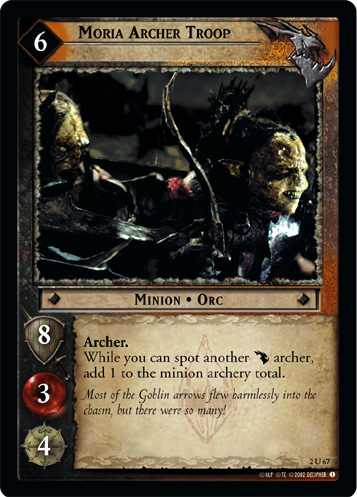 . (Goblin Archer (1R172)
. (Goblin Archer (1R172)
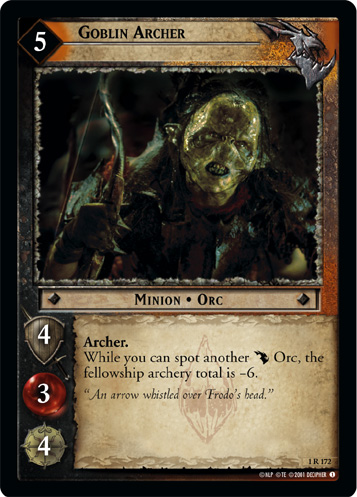 is rarely used due to its high cost and low efficiency.) It can also make use of Bitter Hatred (1U164)
is rarely used due to its high cost and low efficiency.) It can also make use of Bitter Hatred (1U164)
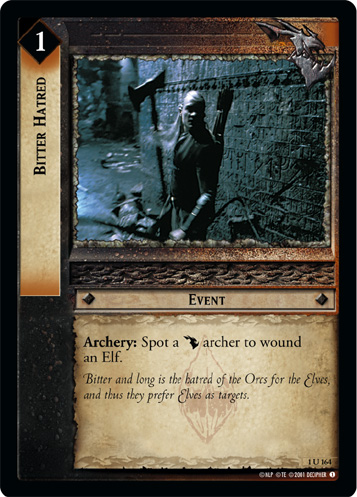 and Pinned Down (1C192)
and Pinned Down (1C192)
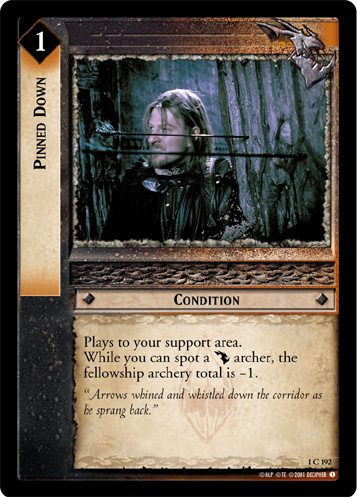 . It also likes some different sites than regular swarm: Great Chasm (2U118)
. It also likes some different sites than regular swarm: Great Chasm (2U118)
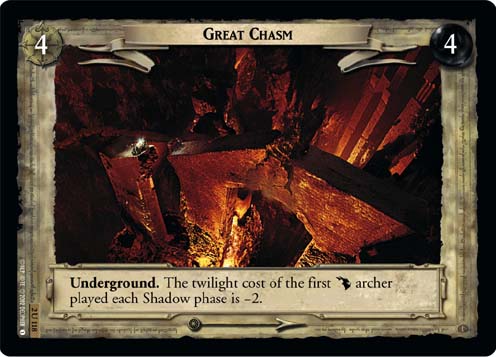 is fine (but still probably worse than the Mithril Mine), Brown Lands (1U357)
is fine (but still probably worse than the Mithril Mine), Brown Lands (1U357)
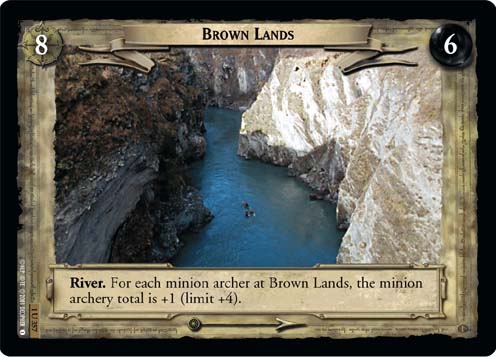 are great, but Anduin Wilderland (1C354)
are great, but Anduin Wilderland (1C354)
 is miserable.
is miserable.
Moria Navy combines the Moria engine above with cheap Corsairs to make a different kind of swarm. Cultural enforcement means this deck is a little less reliable than vanilla
Moria, but the stronger and more versatile Corsairs make the deck more potent when it goes off.
Any Moria deck in later formats can add a
Gollum splash, sometimes consisting of no more than one copy of Gollum, three or four copies of Captured by the Ring (7C53)
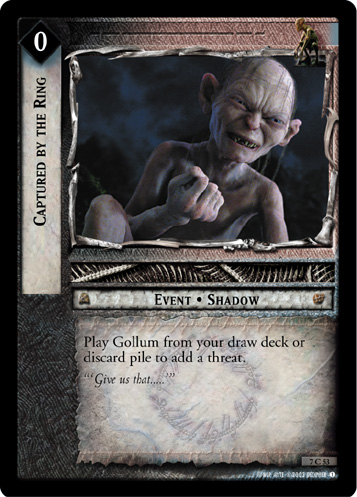 , and possibly a few copies of Evil-smelling Fens (5U22)
, and possibly a few copies of Evil-smelling Fens (5U22)
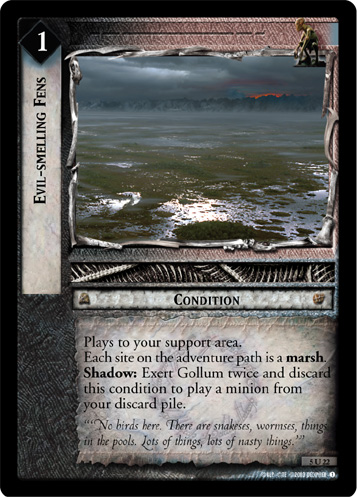 and/or Fat One Wants It (7R57)
and/or Fat One Wants It (7R57)
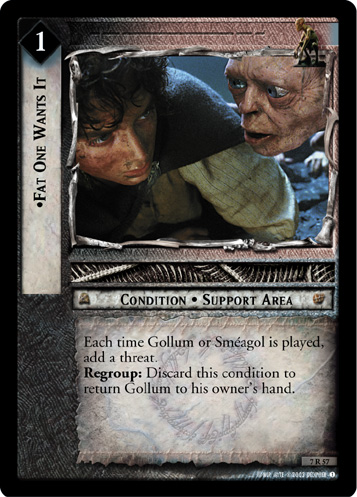 . A handful of threats and an extra body are always welcome.
. A handful of threats and an extra body are always welcome.
The Balrog
See also: Balrog
The Balrog stands more or less on his own, but can't sustain a deck on its own. Think of it more as something you splash into a deck to supplement its main strategy, even if you're splashing it into a Moria deck. It's most popular in Fellowship Block, where it can be downloaded at site 5, The Bridge of Khazad-dûm (1C349)
 , but can't be played at any other site except some versions of site 4. If you do use it, use The Balrog, Flame of Udun (2R52)
, but can't be played at any other site except some versions of site 4. If you do use it, use The Balrog, Flame of Udun (2R52)
 for
for Moria goblin swarm, and The Balrog, Durin's Bane (2C51)
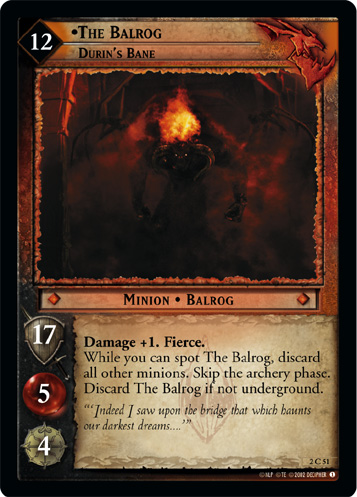 for any other deck. The main reason not to is because the counters to the Balrog are powerful and versatile cards in their own right: Hobbit Stealth (1C298)
for any other deck. The main reason not to is because the counters to the Balrog are powerful and versatile cards in their own right: Hobbit Stealth (1C298)
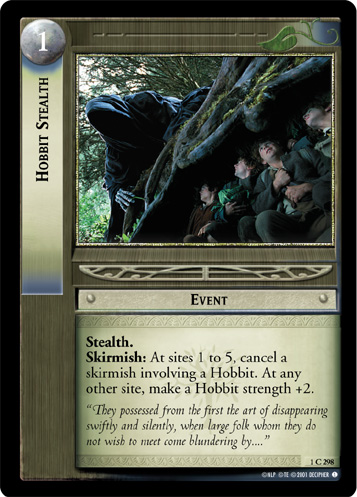 , Boromir, Lord of Gondor (1R96)
, Boromir, Lord of Gondor (1R96)
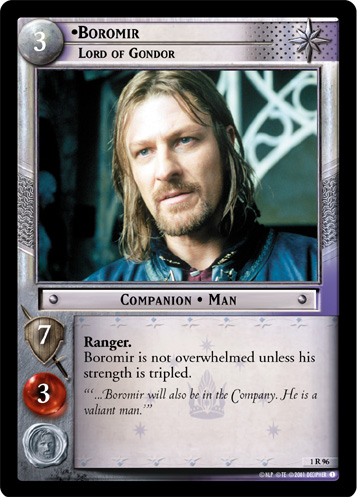 , Armor (1C92)
, Armor (1C92)
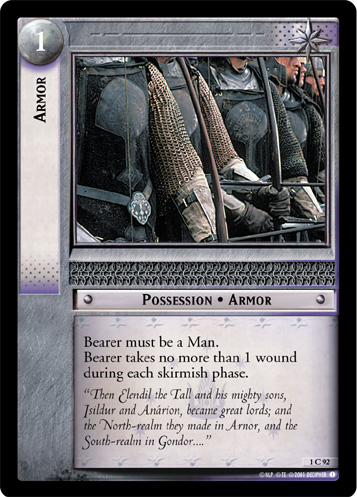 , Gimli's Helm (1R15)
, Gimli's Helm (1R15)
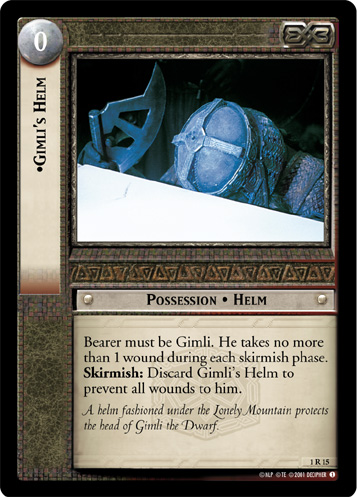 , and Filibert Bolger, Wily Rascal (2C101)
, and Filibert Bolger, Wily Rascal (2C101)
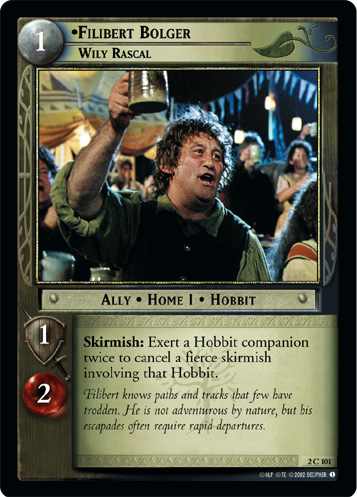 . Even if your opponent doesn't have a counter, they may just be able to sacrifice a used-up support character like Sam, Son of Hamfast (1C311)
. Even if your opponent doesn't have a counter, they may just be able to sacrifice a used-up support character like Sam, Son of Hamfast (1C311)
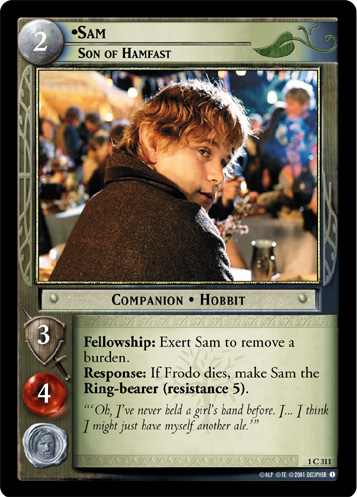 or Merry, Friend to Sam (1R302)
or Merry, Friend to Sam (1R302)
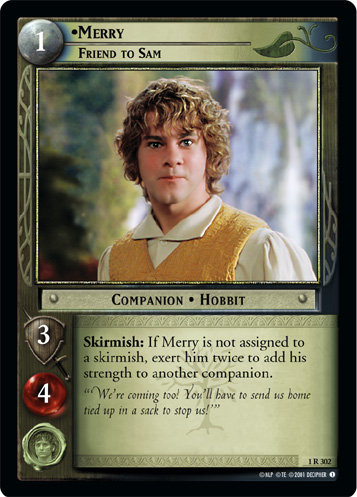 . Whip of Many Thongs (2R74)
. Whip of Many Thongs (2R74)
 counters some of these cards, but not all of them, and it's useless unless you already have it in your hand when your opponent gets to site 5.
counters some of these cards, but not all of them, and it's useless unless you already have it in your hand when your opponent gets to site 5.
In later blocks, the Balrog just isn't very useful. Decipher tried to address its weaknesses, but there are too few Underground sites and its Twilight cost stayed far too high for too long, scuttling those attempts. (Compare Troll of Cirith Gorgor (10R101)
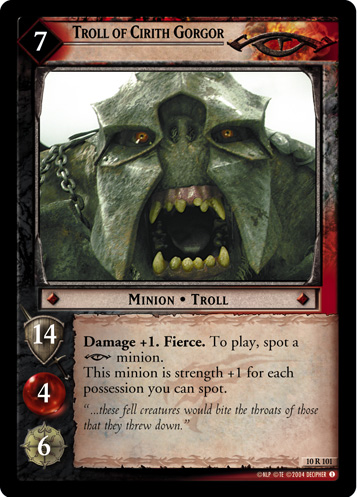 to The Balrog, Terror of Flame and Shadow (6R76)
to The Balrog, Terror of Flame and Shadow (6R76)
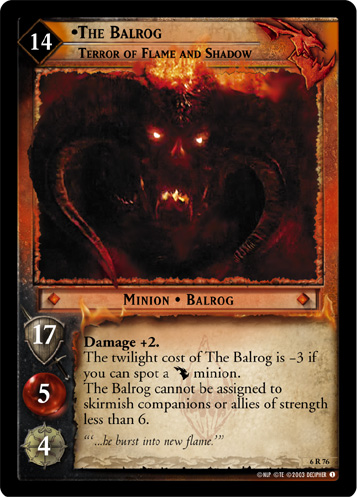 and The Balrog, The Terror of Khazad-dum (12R79)
and The Balrog, The Terror of Khazad-dum (12R79)
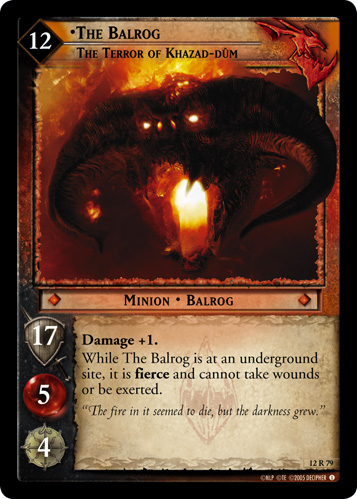 .) The Balrog, Demon of Might (19P18)
.) The Balrog, Demon of Might (19P18)
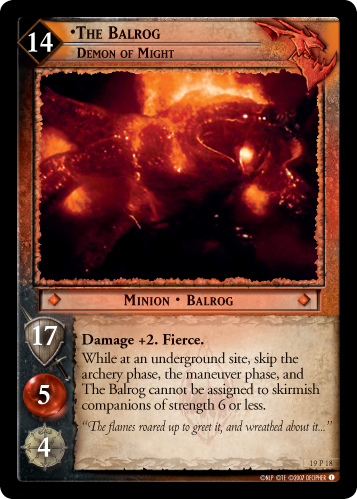 is probably the only one worth seriously considering, as a splash into Underground
is probably the only one worth seriously considering, as a splash into Underground Orc Lurkers, but even then you'll want to make sure it doesn't interfere with any Maneuver Phase abilities you might want to use.
Tentacles
See also: Moria Tentacles
Decks focusing on the Watcher in the Water are an archetype of their own. One of these decks is almost completely useless and infamous as a newbie trap, and one of them is just okay but relies on cards from Age's End.
Midgewater Marshes Moria Lake
Foul Tentacle Huge Tentacle
Watcher in the Water, Keeper of Westgate
Watcher in the Water, Many-Tentacled Creature
Reaching Tentacle Strong Tentacle
| Cultures | |||||||
|---|---|---|---|---|---|---|---|
| Free Peoples | |||||||
| Movie-era Shadow | |||||||
| Shadows-era Shadow | |||||||